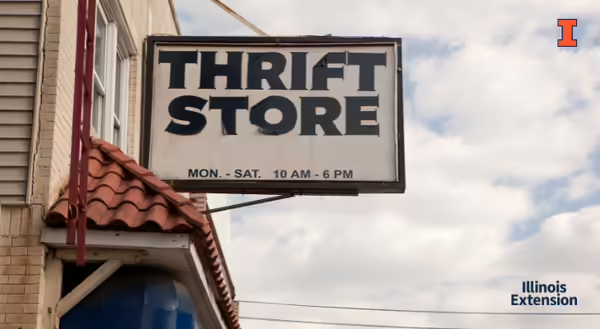
What's safe to bring into my home? I think about this topic often when I shop in thrift stores. I like saving money where I can and sometimes decide to start my search there. Maybe for you, the search starts at individual or community garage sales, consignment stores, or online resale shops. Or maybe you noticed a "free" sign on a curbside item. Secondhand cookware and appliances have lower price tags, but before you buy, make sure it's safe to use at home.
How bad is the defect?
It's understood that secondhand kitchen items have been used before and may have defects, including bent or warped metal, broken-off sections, and scratches. Choose items that are as undamaged as possible. If the item has defects, consider the following:
- Skip kitchenware where the defect touches food. Consider that scratches in the non-stick coating of a skillet will touch the food you cook in it. If scratched enough, the non-stick coating may flake off into your food. Or, if using old metal beaters of a hand mixer, rust might get in your pancake batter. But a scratch on the handle of a spoon is unlikely to touch food and might be a good buy.
- Skip kitchenware that may cause physical harm. For example, a drinking glass with a chip on the rim might cut your lip when you drink from it. Or, a saucepan lid with a loose handle that cannot be tightened might fall off, splash into hot food, and cause a burn. Those would not be safe to buy.
- Skip thrifted canning jars and lids. Many vintage canning jars and lids appear on shelfs in second-hand stores. Because shoppers cannot know if jars, particularly colored glass jars, are made to withstand the pressure of modern canning, it is best to buy new. Same for lids, since as lids should not be reused, and one-piece lids are not recommended for home canning.
Can I eat off this?
Because many thrifted kitchen items are not in their original package, it's hard to know what materials an item is made from and how old it is. This matters because manufacturing practices have changed over the decades, with some materials no longer allowed in new cookware. For example, older ceramic cookware and glass drinkware may contain high levels of lead, a metal that leads to health problems.
- Choose kitchen items with branding information. If the company who made this product is still actively making new products, it is possible to ask questions about what the item is made from and if there are any safety concerns.
- For unknown items, add a barrier. For items without branding information or for items that appear old, determine if a barrier can be used. For example, if buying an older metal muffin tin without a brand, use paper or silicone muffin liners rather than adding muffin batter to the metal tin.
Does it work safely?
For countertop and small kitchen appliances, like toasters or food processors, check for physical defects and ask the store if the appliance works. Be aware there are no warrantees on thrifted appliances, so shoppers assume risks like wiring problems in electric appliances or missing parts.
- Check for appliance recalls. It is possible the appliance is unsafe and was recalled. Call the manufacturer or look online.
- Check that slow cookers reach safe temperatures. Before cooking in a thrifted slow cooker, test the appliance to make sure it gets hot enough. Fill the crock halfway with water and set on a LOW setting for eight hours. Remove lid and insert a food thermometer into the water, without touching the sides or bottom of the crock. If the thermometer reaches 185°F or hotter, the appliance is working well. If the water is colder than 185°F, the cooker is not heating correctly and should not be used.
- Test pressure canners before use. Before preserving food with canning, check that the canner has all its parts. Using just water, test that the canner can hold pressure and is not leaking steam. For pressure canners with dial gauges, call your local Extension office to schedule a test of the gauge.
Thrifting kitchen equipment and appliances is challenging. When in doubt, put the item back and look for something different.
Resources
- Are utensils microwave safe?, United States Department of Agriculture, 2024
- Are Two-Piece Lids Really Necessary?, Iowa State University Extension, 2022
- Cadmium in Food and Foodwares and Lead in Food and Foodwares, Food and Drug Administration, 2024
- Canning Jars and Lids—An Update, PennState Extension, 2024
- Cookware Safety, Clemson Cooperative Extension, 2015
- Crockpot and Slow Cooker Food Safety, Colorado State University Extension, ND
- Food canning jars safety, Michigan State University Extension, 2015
- Is it safe to use rusty utensils?, United States Department of Agriculture, 2024
- Lead in imported cookware, University of Washington, 2022
- Learn about Lead, United States Environmental Protection Agency, 2024
- Melamine in Tableware Questions and Answers, Food and Drug Administration, 2017
- Should I use a wooden cutting board or a plastic one?, United States Department of Agriculture, 2024
- Two Is Better Than One…Especially When It Comes to Canning Lids, North Caroline State University Extension, 2020
- Understanding How the FDA Regulates Substances that Come into Contact with Food, Food and Drug Administration, 2023
- Watch out for kitchenware that could chemically contaminate your food, Michigan State University Extension, 2017
About the Author: Caitlin Mellendorf is an Illinois Extension Nutrition and Wellness Educator serving DeWitt, Macon and Piatt Counties in Central Illinois. She is a Registered Dietitian and her work focuses on helping community members gain the knowledge, skills and tools to live healthier, more nutritious lifestyles. This includes providing programs and answering questions about heart health, diabetes, food safety, food preservation, grocery shopping and cooking. You can reach Caitlin by email at chuth2@illinois.edu or call 217.877.6042.